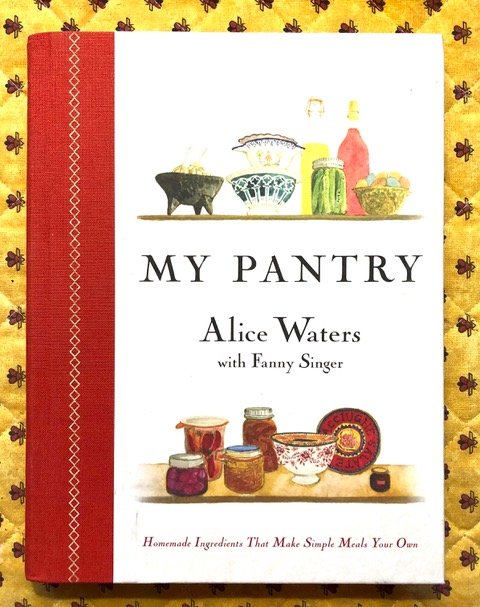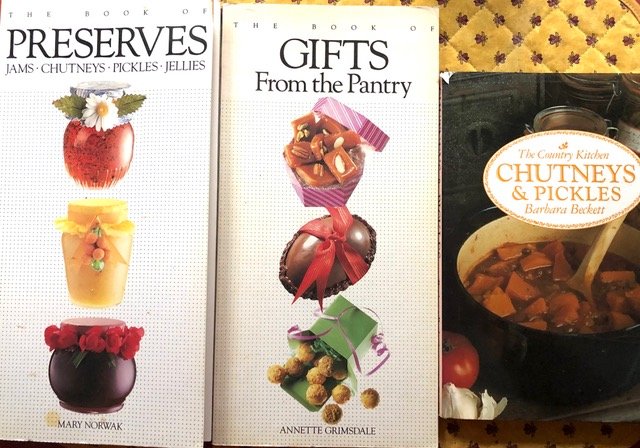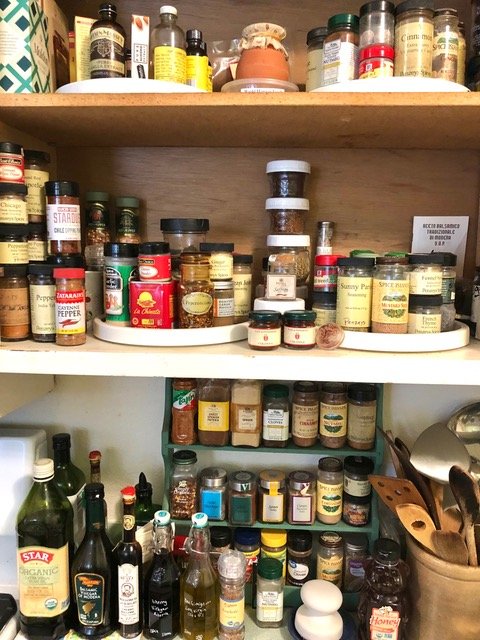My Evolving Pantry
A pantry is one of winter’s richest storehouses. There is a wonderful sense of security and plenty that comes from seeing full shelves and knowing that some items preserved in the larder are the product of my own labors. A larder, from the Old French lardier, refers to a supply of food, a place where food is kept—a pantry. There is no need to drive to the market to find something for dinner when the larder is full.
A decade before I had any notion that I would be living in Missouri or have a pantry of my own, I visited my brother-in-law’s parents in Goshen, IN where they were part of a sizeable Mennonite population. What I remember about Roman and Shirley Gingerich’s house was their small kitchen where every inch of counter space was filled with quart-sized jars of canned, home-grown tomatoes. There in front of me sat a hundred winter suppers-to-be—stews, chilis, spaghetti sauces, lasagnas, and hearty soups.
In Cooking from Quilt Country, author Marcia Adams writes of the time and labor that an Amish housewife will devote each fall to preserving food for the winter months. “It is not unusual to find 600 quarts of canned fruits and vegetables, and 300 quarts of meat and fowl.” In an Amish or Mennonite kitchen, preserving is the part of the yearly cycle that follows planting and the harvest. In the annual fall act of “putting up” the summer’s harvest, families prepare for the winter season. In the spring, the cycle of planting and growing begins again. And when the fall harvest season arrives and the larder is low, it will once again be canning time. Time to turn another summer’s labors into a harvest of riches that can be enjoyed throughout the dormant winter months.
I now live in a quiet neighborhood in the woods, half a continent and decades away from my first pantry in Missouri. In our garage just three steps down from our galley kitchen, a wealth of deep, cedar-lined cupboards line one wall. The one nearest the kitchen door houses a pantry along the lines of the one cookbook author, restauranteur and educator Alice Waters writes of in her book My Pantry, illustrated by her daughter Fanny Singer. Waters, owner of Chez Panisse Restaurant in Berkeley, CA, and founder of the Edible Schoolyard Garden Project, believes that a well-stocked pantry is the secret to creating quick, satisfying meals.
In My Pantry, Waters shares her home cooking philosophy: By preserving seasonal foods to use throughout the year, she can use them as seasonings and flavorings to transform basic staples into delicious, simple meals with very little effort. Her pantry includes bottles and jars and boxes of the following: spice mixtures and condiments; nuts; beans and other legumes; savory preserves; whole grains, preserved fish and meat; cheese; and sweet preserves. She also includes a short list of some of “the books, old and new, that influenced her evolving pantry—and on the ingredients, homemade and otherwise, with which it is stocked.”
In her introduction, Waters writes that the first thing she does when she comes back home from a trip is walk into her kitchen and look around. It lets her know exactly where she is. Perusing her pantry cupboards and kitchen counter she sees “beautiful rows of jars of homemade preserved tomatoes alternating with jars of apricots sparkling in syrup. There’s the crock of chestnut honey, where it belongs; there’re the tin boxes filled with cumin and coriander seeds, if I want to toast and grind a spoonful or two.”
My pantry like Waters’ pantry is always evolving. A masala of spices and herbs are close at hand on the kitchen counter and fill shelves in a kitchen cupboard. Oils and vinegars live on the counter next to the stove for easy access. In the garage pantry, shelves are arm deep with assorted pasta noodles and shells; canned soups, broths and stocks (chicken, beef, turkey, vegetable, ramen); jars of Castelvetrano and Kalamata olives; jars of artichoke hearts, roasted red peppers, and relishes; canned tomatoes (whole, diced, stewed and in a paste; pasta and pesto sauces; bags of Rancho Gordo dried heritage beans; and bottles of extra virgin olive oil. In the kitchen, shelves are stocked with boxes of crackers and biscotti; bags of flour, sugar, cornmeal, polenta, varieties of rice, orzo, quinoa, noodles, baking goods, spices, dried herbs, and chocolate. And our breadbox is always filled with a loaf of Truckee sourdough bread, pain chocolate, Pepperidge Farm English muffins, and a loaf of homemade banana nut bread.
Wherever I am, be it in a country kitchen in the Midwest or in my wonderful neighborhood here in the Sierra Foothills of CA, I am at home in my kitchen with my pantry all around me. As winter fast approaches, my pantry is a comfort.
“A familiar pantry is like being surrounded by friends who won’t let you down, within instant reach.” - Alice Waters




